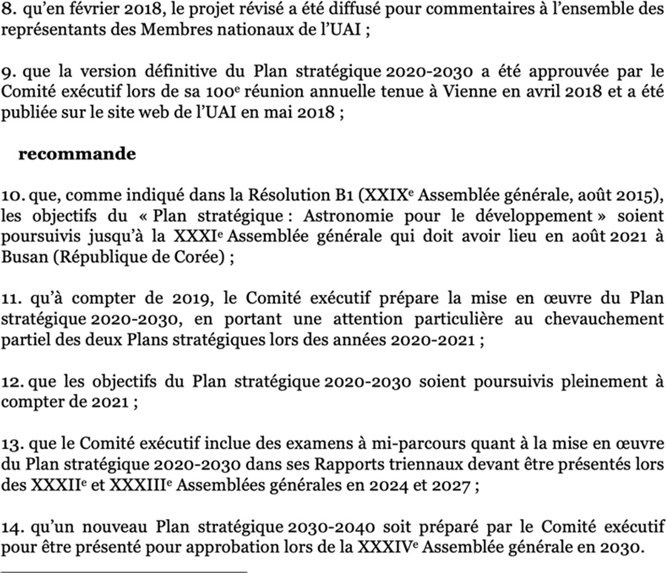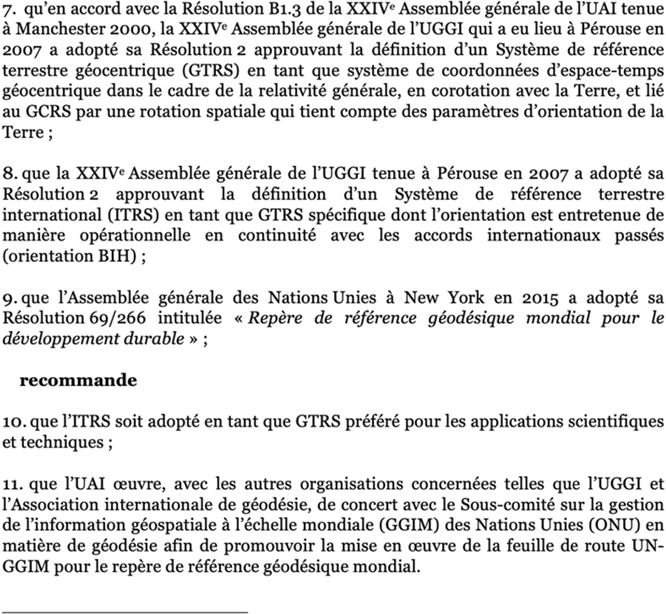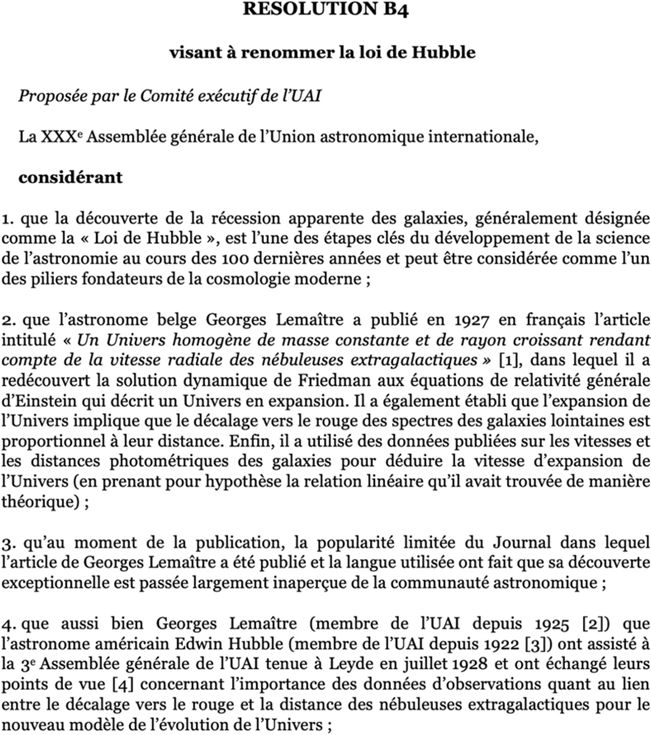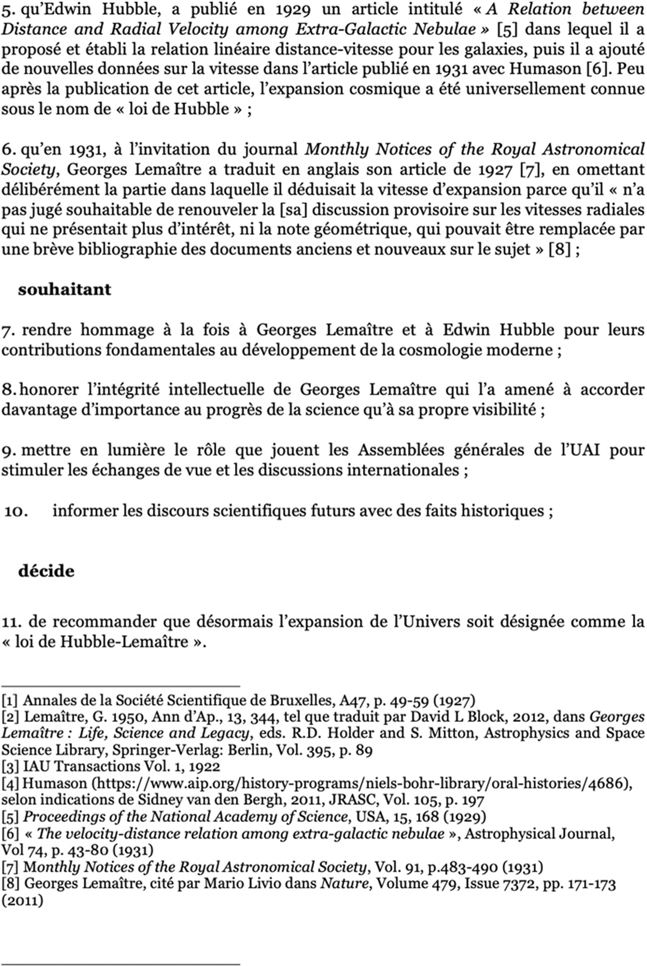1. Resolutions Committee (2015–2018)
The members of the Resolutions Committee for the 2015–2018 triennium were:
Bruce Elmegreen (USA; Chair)
Renée Kraan-Korteweg (South Africa)
Katia Cunha (Brazil)
Toshio Fukushima (Japan)
Sergei Klioner (Germany)
2. Approved Resolutions
RESOLUTION A1
on the IAU Strategic Plan 2020–2030
Proposed by the IAU Executive Committee
The XXX General Assembly of the International Astronomical Union,
considering
1. That the XXIXth General Assembly, meeting in Honolulu, Hawai’i, USA, August 2015, resolved that the “Strategic Plan: Astronomy for the Developing World” should continue until the XXXIst General Assembly to be held in August 2021 in Busan, Republic of Korea.
2. That the Executive Committee should present for approval at the XXXth General Assembly to be held in Vienna, Austria in August 2018 an extended Strategic Plan which addresses the future of the OAD and its activities beyond 2021.
3. That the Executive Committee should consult existing and potential stakeholders in the preparation of this Strategic Plan.
4. That the Executive Committee, in its 98th annual meeting in Mexico City in May 2016 appointed a dedicated Working Group for the preparation of the extended Strategic Plan.
5. That the Executive Committee, in the same 98th meeting, decided that the extended Strategic Plan, called the “IAU Strategic Plan 2020–2030”, should encompass, beyond the Astronomy for Development aspects, all the activities of the IAU.
6. That in the course of 2017 the Working Group solicited inputs from the OAD, OAO and OYA/ISYA, along with the EC Members and Division Presidents and drafted a preliminary version of the IAU Strategic Plan 2020–2030.
7. That in October 2017 the Working Group, before submitting the draft Strategic Plan to the National Members, sounded the opinion of the IAU community at large about the completeness of the Strategic Plan and collected and analyzed more than 150 comments by IAU Individual Members.
8. That in February 2018 the revised draft was distributed for comments to all the IAU National Members representatives.
9. That the final draft of the Strategic Plan 2020–2030 was approved by the Execu- tive Committee in its 100th annual meeting in Vienna in April 2018 and was published on the IAU web pages in May 2018.
resolves
10. That, as stated in the Resolution B1 (XXIXth General Assembly, August 2015), the pursuit of the goals of the Strategic Plan: Astronomy for the Developing World should continue until the XXXI General Assembly to be held in August 2021 in Busan, Republic of Korea.
11. That, starting in 2019, the Executive Committee should prepare the implementation of the Strategic Plan 2020–2030, with particular attention to the partial overlap of the two Strategic Plans in the years 2020–2021.
12. That the goals of the Strategic Plan 2020–2030 should be pursued to their full extent starting in 2021.
13. That the Executive Committee shall include mid-term reviews about the implementation of the Strategic Plan 2020–2030 in the EC Triennial Reports to be presented to the XXXIInd and XXXIIIrd General Assemblies in 2024 and 2027.
14. That a new Strategic Plan 2030–2040 should be prepared by the Executive Committee to be presented for approval to the XXXIVth General Assembly in 2030.
RESOLUTION B1
on Geocentric and International Terrestrial Reference Systems and Frames
Proposed by the IAU Commission A2 (Rotation of the Earth)
The XXX General Assembly of International Astronomical Union,
noting
1. The essential role of the Celestial and Terrestrial Reference Systems and Frames to monitor the Earth’s rotation and orientation in space with the accuracy currently required and foreseen in the near future;
2. The increasing importance of Reference Systems and Frames to science, technology, and society, and in particular to numerous astronomical and other scientific and technical activities involving precise positioning and Earth and space navigation;
3. The adoption of Resolutions B1.1 through B1.9 on reference systems by the XXIV General Assembly of the IAU in Manchester 2000, and especially of Resolution B1.3 on the definition of the Barycentric Celestial Reference System (BCRS) and Geocentric Celestial Reference System (GCRS);
4. The endorsement of IAU 2000 Resolutions B1.1 through B1.9 by Resolution 4 of the XXIII General Assembly of the International Union of Geodesy and Geophysics (IUGG) in Sapporo 2003;
5. That the GCRS is defined as a system of geocentric space-time coordinates within the framework of General Relativity with metric tensor specified by Resolution B1.3 of IAU 2000;
6. The need for a spatial reference system co-rotating with the Earth in its diurnal rotation in space for representing the Earth’s orientation with respect to the GCRS;
recognizing
7. That in agreement with Resolution B1.3 of the XXIV General Assembly of the IAU in Manchester 2000, the XXIV General Assembly of the IUGG in Perugia 2007 adopted Resolution 2 that endorsed the definition of a Geocentric Terrestrial Reference System (GTRS) as a system of geocentric space-time coordinates within the framework of Gen- eral Relativity, co-rotating with the Earth, and related to the GCRS by a spatial rotation which takes into account the Earth orientation parameters;
8. That the XXIV General Assembly of the IUGG in Perugia 2007 adopted Resolution 2 that endorsed the definition of an International Terrestrial Reference System (ITRS) as the specific GTRS for which the orientation is operationally maintained in continuity with past international agreements (BIH orientation);
9. That the General Assembly of the United Nations in New York 2015 adopted Resolution 69/266 entitled “A Global Geodetic Reference Frame for Sustainable Development;”
recommends
10. That the ITRS be adopted as the preferred GTRS for scientific and technical applications; and
11. That the IAU engage, together with other concerned organizations such as the IUGG and the International Association of Geodesy, with the United Nations (UN) Global Geospatial Information Management (GGIM) Subcommittee on Geodesy in order to promote the implementation of the UN-GGIM Road Map for the Global Geodetic Reference Frame.
RESOLUTION B2
on The Third Realization of the International Celestial Reference Frame
Proposed by the IAU Working Group on the Third Realization of the International Celestial Reference Frame
The XXX General Assembly of the International Astronomical Union,
noting
1. that Resolution B2 of the XXIIIrd General Assembly (1997) resolved “that, as from 1 January 1998, the IAU celestial reference system shall be the International Celestial Reference System (ICRS)”;
2. that Resolution B3 of the XXVIIth General Assembly (2009) resolved “that, as from 1 January 2010, the fundamental astrometric realization of the International Celestial Reference System (ICRS) shall be the Second Realization of the International Celestial Reference Frame (ICRF2)”;
3. that Resolution B3 of the XXVIIth General Assembly (2009) resolved “that the organizations responsible for astrometric and geodetic VLBI observing programs (e.g. IERS, IVS) take appropriate measures to continue existing and develop improved VLBI observing and analysis programs to both maintain and improve ICRF2”;
recognizing
4. that since the establishment of ICRF2, continued and new VLBI observing programs conducted by relevant organizations (e.g. IVS, the International VLBI Service for geodesy and astrometry) and individuals on various VLBI arrays and at multiple radio frequen- cies, have almost doubled the volume of astrometric and geodetic VLBI data collected on ICRF2 and add-on radio sources;
5. that since the establishment of ICRF2, improved instrumentation, network coverage, observation strategies, and astronomical and geophysical modeling have significantly im- proved the VLBI data quality and subsequent astrometric analysis of those data;
6. that an IAU Working Group was formed in 2012 to generate the Third Realization of the International Celestial Reference Frame using the entire astrometric and geode- tic VLBI data set and state-of-the-art astronomical and geophysical modeling, with the mandate to complete that realization for presentation at the XXXth General Assembly (2018);
7. that the aforementioned Working Group has generated a prospective Third Realization of the International Celestial Reference Frame, in a coordinate frame aligned onto ICRF2, which represents a significant improvement in terms of source characterization, position accuracy and total number of sources, and thus represents a significant improve- ment in the fundamental realization of the ICRS, compared to ICRF2 adopted at the XXVIIth General Assembly (2009);
resolves
8. that, as from 1 January 2019, the fundamental realization of the International Celestial Reference System (ICRS) shall be the Third Realization of the International Celestial Reference Frame (ICRF3), as constructed by the IAU Working Group on the Third Realization of the International Celestial Reference Frame;
9. that the organizations responsible for astrometric and geodetic VLBI observing pro- grams (e.g. IVS) take appropriate measures to continue and develop such programs, at multiple radio frequencies and with a specific effort on the southern hemisphere, to both maintain and improve ICRF3;
10. that the organizations responsible for defining high-accuracy reference frames at other wavelengths take appropriate measures, together with the International Earth Rotation and Reference Systems Service (IERS), to align those reference frames onto ICRF3 with the highest possible accuracy.
RESOLUTION B3
on preservation, digitization and scientific exploration of historical astronomical data.
Proposed by IAU Inter-Division B-E Working Group on Coordination of Synoptic Observations of the Sun
The XXX General Assembly of the International Astronomical Union,
noting
1. that historical observations provide irreplaceable information regarding changes in the Sun, stars, and other objects of astronomical interest and thereby allow researchers to investigate the time domain and the nature of those transient, evolutionary or recurring changes across a far greater interval than is possible from the relatively short time-span of modern-age (born digital) observations alone;
2. that despite IAU Resolution B3 (2000), which recommended “the transfer of the historic observations onto modern media by digital techniques,” the great majority of archives remain inaccessible digitally;
fearing
3. that appreciation of the unique potential which astronomy’s data from the past offer, regardless of the prevailing technology, is seriously lacking;
4. that although archives and records of astronomy’s analogue observations (photographic, paper, primitive magnetic tapes, etc.) are still being maintained worldwide, many are in state of increasing decay and all are at risk of loss through natural disasters and through human ignorance or error;
5. that many important datasets were acquired and curated by individual projects, which may not have resources or even plans for preserving the data much beyond the present, and
recognizing
6. that the data accumulated over the past decades and even centuries will be lost unless a concentrated action is taken to identify and preserve all significant records;
recommends
7. that a concerted effort be made to ensure the preservation, digitization, and scientific exploration of all of astronomy’s historical data, both analogue and primitive digital, and associated records.
RESOLUTION B4
on a suggested renaming of the Hubble Law
Proposed by the IAU Executive Committee
The XXX General Assembly of the International Astronomical Union,
considering
1. that the discovery of the apparent recession of the galaxies, which is usually referred to as the “Hubble law,” is one of the major milestones in the development of the science of Astronomy during the last 100 years and can be considered one of the founding pillars of modern Cosmology;
2. that the Belgian astronomer Georges Lemaître, in 1927 published (in French) the paper entitled “Un Univers homogène de masse constante et de rayon croissant rendant compte de la vitesse radiale des nébuleuses extra-galactiques” [1]. In this he first rediscovers Friedman’s dynamic solution to Einstein’s general relativity equations that describes an expanding universe. He also derives that the expansion of the universe implies the spectra of distant galaxies are redshifted by an amount proportional to their distance. Finally he uses published data on the velocities and photometric distances of galaxies to derive the rate of expansion of the universe (assuming the linear relation he had found on theoretical grounds);
3. that, at the time of publication, the limited popularity of the Journal in which Lemaître’s paper appeared and the language used made his remarkable discovery largely unperceived by the astronomical community;
4. that both Georges Lemaître (an IAU member since 1925 [2]) and the American astronomer Edwin Hubble (an IAU member since 1922 [3]) attended the 3rd IAU General Assembly in Leiden in July 1928 and exchanged views [4] about the relevance of the redshift vs distance observational data of the extragalactic nebulae to the emerging evolutionary model of the universe;
5. that Edwin Hubble, in 1929 published the paper entitled “A Relation between Distance and Radial Velocity among Extra-Galactic Nebulae” [5] in which he proposed and derived the linear distance-velocity relation for galaxies, ultimately including new velocity data in his 1931 paper with Humason [6]. Soon after the publication of his papers, the cosmic expansion became universally known as the “Hubble law”;
6. that, in 1931, on invitation by the Journal Monthly Notices of the Royal Astronomical Society, G. Lemaître translated in English his original 1927 paper [7], deliberately omitting the section in which he derived the rate of expansion because he “did not find advisable to reprint the [his] provisional discussion of radial velocities which is clearly of no actual interest, and also the geometrical note, which could be replaced by a small bibliography of ancient and new papers on the subject” [8];
desiring
7. to pay tribute to both Georges Lemaître and Edwin Hubble for their fundamental contributions to the development of modern cosmology;
8. to honour the intellectual integrity of Georges Lemaître that made him value more the progress of science rather than his own visibility;
9. to highlight the role of the IAU General Assemblies in fostering exchanges of views and international discussions;
10. to inform the future scientific discourses with historical facts;
resolves
11. to recommend that from now on the expansion of the universe be referred to as the “Hubble-Lemaître law”.
[1] Annales de la Société Scientifique de Bruxelles, A47, p. 49–59 (1927)
[2] Lemaître, G. 1950, Ann d’ Ap., 13, 344, as translated by David L Block, 2012, in Georges Lemaître: Life, Science and Legacy, eds. R.D. Holder and S. Mitton, Astrophysics and Space Science Library, Springer-Verlag: Berlin, Vol. 395, p. 89
[3] IAU Transactions IB, 1922
[4] Humason (https://www.aip.org/history-programs/niels-bohr-library/oral-histories/4686), as reported by Sidney van den Bergh, 2011, JRASC, Vol. 105, p. 197
[5] Proceedings of the National Academy of Science, USA, 15, 168 (1929)
[6] “The velocity-distance relation among extra-galactic nebulae”, Astrophysical Journal, Vol 74, p. 43–80 (1931)
[7] Monthly Notices of the Royal Astronomical Society, Vol. 91, p.483–490 (1931)
[8] Georges Lemaître, quoted by Mario Livio in Nature, Volume 479, Issue 7372, pp. 171–173
3. Report by the Resolutions Committee Chair on Resolution B4
Bruce Elmegreen, Chair of the Resolutions Committee
Electronic vote on the Resolution B4 “on a suggested renaming of the Hubble Law”
Background
Five Resolutions were proposed for approval at the XXXth IAU General Assembly (Vienna, August 20th–31st, 2018). They were announced and posted on the IAU web site on June 20th (see https://www.iau.org/news/announcements/detail/ann18029/) and initially they did not generate any comments by the members.
However, after the Resolutions were highlighted in the e-Newsletter #7 in July (see https://www.iau.org/publications/e-newsletters/html/72/), a lively discussion started on the Resolution B4 “on a suggested renaming of the Hubble Law”. The comments and suggestions were well received by the Resolutions Committee, chaired by Bruce Elmegreen, and were used to improve the text of the Resolution as well as to increase the supporting bibliography.
From the comments received before the General Assembly, it was becoming clear that the opinion of the community was divided and the result of the vote would be uncertain. In such a situation, which was not necessarily foreseeable in advance, the IAU Executive Committee, in its Meeting #101 (Aug. 19th, 2018), agreed to proceed with the regular presentation of the Resolutions during the I Business Session (Aug. 21st, 2018) followed by the vote during the II Business Session (Aug. 30th, 2018), however decided to consider the vote about the Resolution B4 as indicative of the opinion of the members physically present at the II Business Session and to propose to the entire community of IAU members to express their vote electronically shortly after the GA. The result of the electronic vote would be the definitive one.
The Executive Committee decided also that the presentation of the e-vote should include the result of the straw vote at the GA and a summary of the discussion that took place both via mail and live during the II Business Session.
The final text of the Resolution B4
The text of the Resolution B4 has been modified several times from its first edition, taking into account the comments and suggestions received by the Resolution Committee up to the II Business Session of the GA. The final text which is proposed for electronic voting is reported in this Chapter.
The main motivations of the Resolution B4 are the following:
— To pay tribute to both George Lemaîre and Edwin Hubble for their fundamental contribution to the development of modern cosmology, informing future discourses with historical facts.
— To highlight the role of the IAU in fostering exchanges of views and international discussions
It should be stressed that the Resolution does not formally establish a new name of the “Hubble law,” but simply suggests that in future discourses the formulation “Hubble-Lemaîre law” is preferred.
The supporting Bibliography
For convenience of the voters, the main supporting Bibliography, in particular that quoted in the Resolution, is included in this Chapter for Resolution B4.
We wish to highlight an excerpt form the paper by David L. Block, “Georges Lemaître and Stigler’s Law of Eponymy,” which reports an interesting comment on the matter by Lemaître himself:
“In a Comment published in Nature Mario Livio (Nature, 479, 171, 2011) has unearthed a letter from Lemaître to W. M. Smart (dated 9 March 1931). From that document, it is clear that Lemaître himself translated his 1927 paper into English and who also omitted his determination of the coefficient of expansion of the Universe (H0) from values of radial velocities available as of 1927. However, in his Comment Livio omits a vital reference, namely thoughts penned by Lemaître himself in 1950 (L’expansion de l’Univers, Bibliographie: Annales d’Astrophysique, 13, 344):
About my contribution of 1927, I do not want to discuss if I was a professional astronomer. I was, in any event, an IAU member (Cambridge, 1925), and I had studied astronomy for two years, a year with Eddington and another year in the U.S. observatories. I visited Slipher and Hubble and heard him in Washington, in 1925, making his memorable communication about the distance [to] the Andromeda nebula. While my Mathematics bibliography was seriously in default since I did not know the work of Friedmann, it is perfectly up to date from the astronomical point of view; I calculate [in my contribution] the coefficient of expansion (575 km per sec per megaparsecs, 625 with a questionable statistical correction). Of course, before the discovery and study of clusters of nebulae, there was no point to establish the Hubble law, but only to calculate its coefficient. The title of my note leaves no doubt on my intentions: A Universe with a constant mass and increasing radius as an explanation of the radial velocity of extra-galactic nebulae. I apologize that all of this is too personal. But, as noted by the author (p. 161) “the history of this science competition is not irrelevant” and it is useful to highlight the details to enable an exact understanding of the scope of the argument that can be drawn from this. (italics added for emphasis)
In 1950, Lemaître clearly did not want the rich fusion of theory and observations contained in his 1927 paper to be buried in the sands of time.”
Concerning point 6 in the Resolution, we wish to highlight an interesting comment by Virginia Trimble which suggests that the expression “actual interest” used by Lemaître in his letter to MNRAS is a poor translation into English of the French “intérêt actuel”. It should therefore be better interpreted as “current interest”.
Discussion: questions raised and answers by the Resolution Committee
The discussion on the Resolution B4 was very lively both in some of the Division Days meetings and in particular during the II Business Session. Unfortunately the latter had to be stopped after 20 minutes in order to keep the schedule of the Session and of the subsequent Closing Ceremony. However, some of the questions that were not presented at the Session, were sent by email to the Resolution Committee. Here below a summary of the most relevant Q&A.
Q. Is the IAU recommending that any other “Hubble”-named things change?
A. No
Q. Will this lead to other re-namings?
A. This particular case involves one of the most important astronomical discoveries and the history is clear about the contributions by Lemaître and by the IAU. Informing future discourses about this history can only be good. Future discourses about other historical precedents should strive to be correct too, and if the current resolution begins this conversation, then that is good. This does not mean that other historical reflections should be modified by IAU resolutions.
Q. Should others who noticed the correlation between galaxy velocity and size or brightness or distance be recognized also in this resolution?
A. No, the others (Wirtz, Lundmark, …) are noted in one of the bibliographic references, but also did not interpret the relationship as expansion (they referred only to the static de Sitter or Einstein universes). The resolution recommends only that the “expansion of the Universe be referred to as the “Hubble-Lemaître law”, not that the velocity-distance relation be given additional names.
Q. Should other contributors to the data used in the early expansion law (Slipher, Leavitt, Stromgren,) be acknowledged as well?
A. No, because they did not use their data nor invent new theory to discover the Universal Expansion.
The straw vote.
After the discussion, the Assembly was asked to vote in the following sequence: votes against, abstentions and votes in favour. To facilitate the work of the official tellers, the vote was called by sections of the Hall. The results are indicated below: please note that, being a straw vote, the General Secretary decided not to resolve the minor discrepancies among the scores reported by the three independent tellers. The results are therefore approximate within few percent.
Total number of voters (IAU Individual Members): 385
Votes against: 53 (14%)
Abstensions: 46 (12%)
Votes in favour: 286 (74%)
All the Individual and Junior Members of the IAU (including those present in Vienna) are now invited to express their vote electronically (instructions follows).
The e-vote will close on Oct. 26th 24:00 UTC and the result will be available on the web site of the Company My-Voice soon after. (The resolution was subsequently approved after the October vote was concluded.)
4. Résolutions Approuvées











